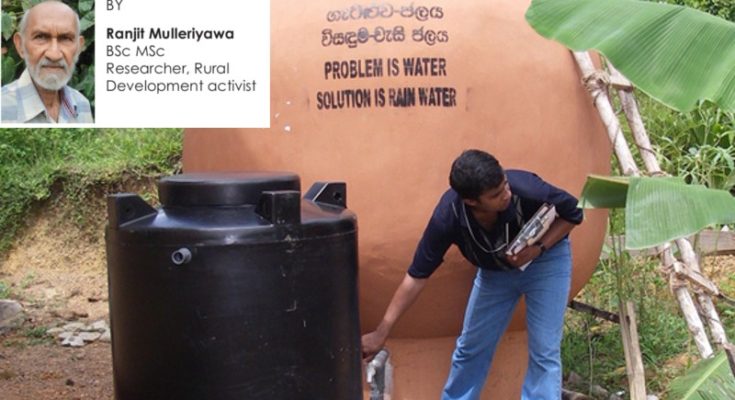In memory of Mr. Ranjith Mulleriyawa who was well known for his advocacy of simple farming and his work and writings on Chronic Kidney Disease.He was a contributor for the Sri Lankan Scientist Magazine too, and this article by him had been included in the second issue of the magazine.
Most people living in CKDu endemic villages obtain their drinking water from open dug wells, where the water tends to contain high concentrations of Fluoride (2-4 ppm) and dissolved Calcium and Magnesium salts giving rise to the condition known as “hard water”. There is widespread consensus among doctors and scientists that improving the quality of drinking water in these areas may prevent, or retard the progress of this kidney disease. This was recognized more than two years ago, but obtaining the required potable water still continues to be an illusion for many people living in the affected areas.
Seeking suitable solutions
A suitable solution must meet the following criteria:
- Be technically effective and viable within the specific context where the problem exists (dry zone villages).
- Socially acceptable and sustainable by the communities with minimum dependence on ‘outsiders’.
- Economically viable and cost effective.
- Environmentally sustainable.
Context
It is essential that the specific context of CKDu affected villages be considered in deciding the most appropriate method of providing clean drinking water to the resident population.
People in the disease affected areas are desperately poor. Their houses are widely scattered. The roads are dilapidated. Public services – transport, healthcare, education, extension services and communication facilities, are poorly developed. Rural institutions (farmer organizations, rural development societies) are mostly dysfunctional. Electricity is hard to come by; even where electricity is available, voltage fluctuations and interruptions to power supply are frequent.
These areas receive an annual rainfall of 1000-1200 mm. Over 75 per cent of this rainfall occurs within four months of the year (October, Nov. Dec. and January) giving rise to frequent floods. Total annual rainfall tends to be relatively consistent. However its distribution pattern has fluctuated widely in recent years.
Many surface water bodies (village ‘tanks’) tend to dry up during the dry months of July, August and September. Ground water is scarce and over exploited by haphazard construction of agro-wells. Agro-wells in Anuradhapura district have exceeded the ecologically permissible limit. Quality of ground water is ‘poor’ due to high concentrations of Fluoride and dissolved Calcium and Magnesium salts.
Providing clean drinking water through rainwater harvesting
The obvious and most practical solution for the drinking water problem of these rural communities is the collection and storage of rainwater- one of the purest forms of water available to man. All that is required is a storage structure to collect and store rainwater running off the roofs of houses during the rainy season. Ensuring sufficient water to last through the 6-8 months of dry weather (February to September) requires a storage structure capable of holding at least 5000 liters of water.
It is estimated that a household consisting of 5 persons, would require approximately 20 liters of water per day for drinking and cooking purposes (4 liters/person/day). A 5000 liter capacity plastic storage tank complete with gutter and down pipe will cost Rs. 50,000. It is guaranteed to last at least ten years, and will provide households with independent access to potable water at an affordable price (25 cents/liter) at their door step. Rainwater harvesting is the most rational, cost effective, socially acceptable and ecologically sustainable method of providing clean drinking water to widely scattered rural households in the dry zone. The technology involved is simple and easy for rural people to understand, implement and sustain.
Seeing is believing
Reverse Osmosis Systems (R.O. Plants)
We do not believe that R.O. Plants are a viable solution for providing potable water for the following reasons:
1. They are heavily dependent on imported technology.
2. They are expensive to install and maintain requiring skilled technicians to ensure effective functioning of the filter membrane. R.O. Plants currently established cost approximately Rs. 2 million each. Filter membranes cost Rs.200, 000 – 300,000 and need regular replacement.
3. Require an institutional set up to manage the operation and maintenance of equipment, and ensure equitable distribution of purified water to households.
4. R.O. water costs the consumer (poor villager) four to eight times (Rs1-2 per liter) more than a liter of rain water.
5. Reverse Osmosis facilities tend to be established in centralized locations (Schools, Hospitals and Community Centers). Villagers have to collect their water requirements (almost daily) from here. This is inconvenient and time consuming.
6. Villagers have to depend heavily on ‘outsides’ to provide their potable water requirements. They are vary of the consequences of such dependence.
7. Require electricity, water pumps, pressure pumps, expensive filter membranes and dug wells. Large R.O. implement and sustain. plants also require buildings to house them.
8. Effluent water carrying toxic substances is released to the environment (adding to further contamination of ground water). National Environment Act No 47 of 1980 prohibits discharge of effluents containing over 2mg/L (2 ppm) of Fluoride into surface water bodies (drainage canals etc). Feed water entering R.O. plants in CKDu endemic regions of the NCP frequently exceed 2 ppm Fluoride. Effluent water discharged from RO plants in such areas, is, therefore, likely to contain Fluoride levels exceeding the maximum permissible limit stipulated by the Environment Act.
9. Are wasteful of water. For every liter of purified water, approximately one liter of water goes waste as effluent.
10. R. O. Plants depend on ground water (wells) as water source. Within the prevailing context of already over exploited ground water reserves, limited storage capacity of the ‘regolith aquifer of the hard rock region’ (a characteristic feature of the ‘dry zone’), further stress on precious groundwater reserves is fraught with danger. What will be the ecological consequences of heavy groundwater extraction by a large number of high capacity R.O. plants?
11. R.O. Plants are NOT sustainable within the current ecological and socio-economic context of dry zone farming communities.
12. What are the consequences for the National Economy of installing and maintaining several imported R.O. plants costing 8,000-10,000 U.S. $ each?
The only advantage of an R.O. plant seems to be the lower capital investment per household (which may vary from 5,000 to 10,000 rupees depending on the capacity of equipment). Cost per liter of purified water to the consumer, is however four to eight times higher than rainwater harvesting systems (as a result of increased operational costs).





